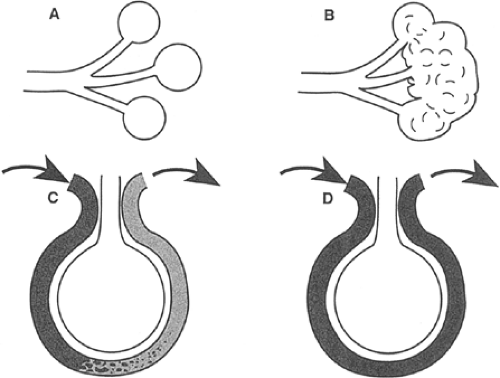Pulmonary Heart Disease
This chapter is about the way chronic lung disease affects the cardiovascular system. Many kinds of lung disease create a barrier to the flow of blood from the right heart into the lungs. This happens because of scarring and other changes in the lungs. The high resistance to blood flow causes back pressure in the pulmonary arteries, the right heart, and the veins of the body. This increased pressure forces edema fluid out into the tissues. The condition is called cor pulmonale, or pulmonary heart disease.
Chronic lung disease and the pulmonary heart disease that goes with it is one of the most common causes of disability and slow death in the Western world today. It is 90% caused by humans and often totally unnecessary. Remember right heart failure? Look again at Figure 6-5 and reread the section on right heart failure in Chapter 7.
Chronic Obstructive Pulmonary Disease
Far and away the most common cause of pulmonary heart disease is the condition called chronic obstructive pulmonary disease (COPD). It’s a combination of emphysema and bronchitis. It comes in two principal forms. You’ve seen many victims of this disease in public places and you would certainly have been aware that they were very sick—sometimes in agony. Typically, you would have seen an older person who was fighting for breath in a peculiar way. The victim would inhale with a sudden effort and then force the breath out with a prolonged, audible sigh, often with a wheeze. You would guess that the patient actually had to force the air out of the lungs, and you’d be right. What you were looking at was emphysema.
In this disease, the small air cells of the lungs rupture into large, inefficient sacs. These sacs don’t exchange oxygen very well, and they tend to trap air (Fig. 16-1). They act exactly like the Chinese finger trap of your childhood: you could push your finger in, but you couldn’t pull it back out.
The trapping of air in these sacs causes the long, slow, agonizing exhalations of emphysema. The patient does manage to get enough oxygen into the body, but it’s done with tremendous effort. For that reason, these patients are called pink puffers.
 FIGURE 16-1 A. The alveoli are normally separate small sacs, like grapes on the end of stems. B. With emphysema, many alveoli rupture, forming large inefficient sacs. C. Normally, blood carries oxygen away from the lungs. D. When air cells are plugged, blood from the veins flows through the lungs without picking up oxygen.
Stay updated, free articles. Join our Telegram channel
Full access? Get Clinical Tree
 Get Clinical Tree app for offline access
Get Clinical Tree app for offline access

|